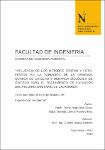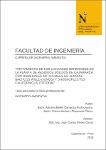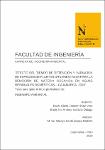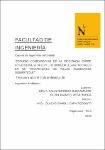Mostrar el registro sencillo del ítem
Influencia de los métodos fenton y fotofenton en la variación de la demanda química de oxígeno y demanda biológica de oxígeno para el tratamiento de lixiviados del relleno sanitario de Cajamarca
| dc.contributor.advisor | Licapa Redolfo, Gladys | |
| dc.contributor.author | Alva Rojas, Frank Hugo | |
| dc.contributor.author | Romero Max, Brenda Lorens | |
| dc.date.accessioned | 2018-10-21T16:19:16Z | |
| dc.date.available | 2018-10-21T16:19:16Z | |
| dc.date.issued | 2018-09-10 | |
| dc.identifier.citation | Alva, F. H., & Romero, B. L. (2018). Influencia de los métodos fenton y fotofenton en la variación de la demanda química de oxígeno y demanda biológica de oxígeno para el tratamiento de lixiviados del relleno sanitario de Cajamarca (Tesis de licenciatura). Repositorio de la Universidad Privada del Norte. Recuperado de http://hdl.handle.net/11537/13980 | es_PE |
| dc.identifier.other | TES 628.32 ALVA 2018 | es_PE |
| dc.identifier.uri | https://hdl.handle.net/11537/13980 | |
| dc.description.abstract | RESUMEN El objetivo del presente trabajo fue evaluar la influencia de los métodos Fenton y foto - Fenton en la variación de la demanda química de oxígeno y demanda biológica de oxígeno para el tratamiento de lixiviados del relleno sanitario de Cajamarca, ya que estos han sido ampliamente estudiados como las mejores alternativas para el tratamiento de diversos contaminantes orgánicos en el agua. Una solución de ion hierro (Fe ) y otra de peróxido de hidrógeno (H 2 O 2 ) constituyen el reactivo de Fenton, cuando se utilizan soluciones de ion férrico (Fe 2+ ) se denomina reactivo tipo Fenton, en el cual se generan radical hidroxilo altamente reactivo (OH•) que pueden oxidar diversos contaminantes orgánicos. Ambos sistemas oxidantes son lentos y necesitan la asistencia de energía, como la irradiación de luz solar y UV, estos sistemas se denominan procesos Foto- Fenton. El lixiviado crudo empleado fue colectado en el relleno sanitario de Cajamarca, Perú. El experimento se dividió en tres etapas: fase de campo, fase de laboratorio y fase de gabinete. En la fase de campo se tomaron muestras de los lixiviados antes de realizar el pre- tratamiento y tratamiento determinando diversos parámetros como: pH, la demanda química de oxígeno (DQO) y demanda biológica de oxígeno (DBO) de los cuales sus valores fueron: pH (9.1), DQO (1051.5 mg O₂/L) y DBO (287 mg O₂/L). Con esos datos fue posible conocer el índice de biodegradabilidad 3+ (IB) de 0.272 lo cual indica que el lixiviado es moderadamente biodegradable. Los resultados en la fase de laboratorio del tratamiento muestran valores favorables en la aplicación del método Fenton y foto – Fenton, que presentaron una disminución hasta llegar a los valores de 9.2 mg O₂/L y 7.6 mg O₂/L en la evaluación de la demanda biológica de oxígeno, una variación de demanda química de oxígeno en las concentraciones a 536.6 mg O₂/L y 581.1 mg O₂/L y por último presentan un pH de 8.32 (Proceso Fenton) y 7.01 (foto- Fenton). Finalmente, se realizaron comparaciones entre los lixiviados sin el tratamiento y con el tratamiento dando resultados aceptables en la disminución de la demanda química de oxígeno utilizando el método Fenton (aunque no se logró alcanzar los Límites Máximos Permisibles del MINAM) y una disminución de la demanda biológica de oxígeno y pH muy favorables con el método foto- Fenton, alcanzando concentraciones dentro del rango de límites máximos permisibles para efluentes de plantas de tratamiento de aguas residuales domésticas o municipales. | es_PE |
| dc.description.abstract | ABSTRACT The objective of the present work was the evaluation of the Fenton and photo: Fenton methods in the variation of the chemical demand of oxygen and demand for the treatment of leachates from the Cajamarca sanitary landfill, since they have been studied as the best alternatives for the treatment of organic materials in water. A solution of Fe and another of hydrogen hydroxide H 2 O 2 constitutes the Fenton reagent, when using Fe 3 + 2 + solutions it is called a Fenton type reagent, in which a highly reactive hydroxyl radical (•OH) is generated that can oxidize in polluting environments organic Both oxidant systems are more recent and need the assistance of energy, such as irradiation of sunlight and UV, these systems are called photo-Fenton processes. The raw leachate used was collected in the sanitary landfill of Cajamarca, Peru. The process was divided into three stages: field phase, laboratory phase and cabinet phase. In the field phase, samples of the leachate were taken before carrying out the previous treatment and parameters such as pH, chemical oxygen demand and biological demand of the possible values were determined: pH (9.1), COD (1051.5 mg O₂/L) and BOD (287 mg O₂/L). With these data it is possible to know the biodegradability index (IB) of 0.272, which indicates that the leachate is moderately biodegradable. The results in the laboratory phase of the treatment reflect favorable values in the application of the Fenton and photo - Fenton method, which presents a decrease of 9.2 mg O₂/L and 7.6 mg O₂/L in the evaluation of biological demand of oxygen, one of 536.6 mg O₂/L and 581.1 mg O₂/L and finally have a pH of 8.32 (Fenton Process) and 7.01 (photo Fenton). Finally, comparisons were made between the authorized users and the treatment giving acceptable results in the decrease of the chemical demand of the use of the Fenton method (although it was not achieved in the future) Permits of the MINAM and a decrease of the biological demand of oxygen and pH very favorable with the photo-Fenton method, reaching concentrations within the range of maximum permissible limits for domestic or municipal wastewater treatment plants. | es_PE |
| dc.description.uri | Tesis | es_PE |
| dc.format | application/pdf | es_PE |
| dc.language.iso | spa | es_PE |
| dc.publisher | Universidad Privada del Norte | es_PE |
| dc.rights | info:eu-repo/semantics/closedAccess | es_PE |
| dc.source | Universidad Privada del Norte | es_PE |
| dc.source | Repositorio Institucional - UPN | es_PE |
| dc.subject | Tratamiento | es_PE |
| dc.subject | Temperatura | es_PE |
| dc.subject | Estudios de impacto ambiental | es_PE |
| dc.title | Influencia de los métodos fenton y fotofenton en la variación de la demanda química de oxígeno y demanda biológica de oxígeno para el tratamiento de lixiviados del relleno sanitario de Cajamarca | es_PE |
| dc.type | info:eu-repo/semantics/bachelorThesis | es_PE |
| thesis.degree.grantor | Universidad Privada del Norte. Facultad de Ingeniería | es_PE |
| thesis.degree.level | Título Profesional | es_PE |
| thesis.degree.discipline | Ingeniería Ambiental | es_PE |
| thesis.degree.name | Ingeniero Ambiental | es_PE |
| dc.publisher.country | PE | es_PE |
| dc.subject.ocde | https://purl.org/pe-repo/ocde/ford#2.07.00 | es_PE |
| thesis.degree.program | Pregrado | es_PE |
| dc.description.sede | Cajamarca | es_PE |
| renati.discipline | 521066 | es_PE |
| renati.level | https://purl.org/pe-repo/renati/level#tituloProfesional | es_PE |
| renati.type | https://purl.org/pe-repo/renati/type#tesis | es_PE |
Ficheros en el ítem
Este ítem aparece en la(s) siguiente(s) colección(ones)
-
Tesis [454]





